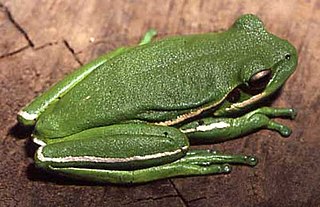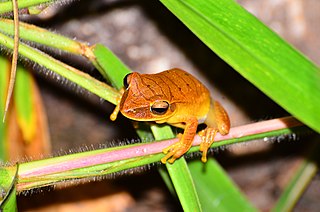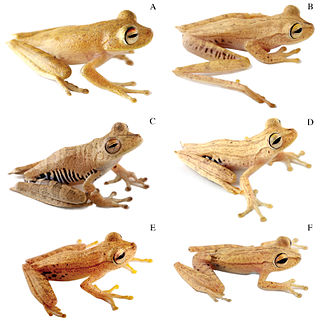
The canebrake tree frogs are a frog genus Aplastodiscus. They are in the family Hylidae. Residing primarily in southeast regions of Brazil near the Atlantic coast. The exception is the Aplastodiscus perviridis which is found mostly in Brazil, but has also been documented being in Argentina, and might reside in Paraguay. The major revision of the Hylidae genus expanded it to include 12 more species originally from Hyla. Before the revision there were only 2 species. There are currently 16 described species with the most recent addition Aplastodiscus heterophonicus being described in 2021.

Boana is a genus of frogs in the family Hylidae. They are commonly known as gladiator frogs, gladiator treefrogs or Wagler Neotropical treefrogs. These frogs are distributed in the tropical Central and South America from Nicaragua to Argentina, as well as in the Caribbean.

The white-spotted tree frog is a species of frog in the family Hylidae found in Argentina, Bolivia, Brazil, Paraguay, and Uruguay. Its natural habitats are moist savanna, subtropical or tropical moist shrubland, subtropical or tropical high-altitude shrubland, intermittent rivers, intermittent freshwater lakes, freshwater marshes, intermittent freshwater marshes, and urban areas.
Boana beckeri is a species of frog in the family Hylidae. It is endemic to Brazil and is only known from a handful of localities in southern Minas Gerais and adjacent northeastern São Paulo. The specific name beckeri honors Johann Becker, Brazilian zoologist who collected many of the types.

The Amapa tree frog is a species of frog in the family Hylidae found in northern Brazil in the Amapá state, French Guiana, and southeastern Suriname. It belongs to the Boana albopunctata species group.

Boana xerophylla is a species of frog in the family Hylidae. It's found in northern South America.
Boana latistriata is a species of frog in the family Hylidae. It is endemic to Brazil and only known from its type locality, Itatiaia National Park, and from Marmelópolis, both in the state of Minas Gerais. The specific name latistriata refers to the wide stripes on the back of this frog.

Boana prasina is a species of frog in the family Hylidae. It is endemic to Southeastern Brazil and is observed in many Brazilian states: Minas Gerais, Rio de Janeiro, and São Paulo, and possibly further south. The common name of Boana prasina is Burmeister's treefrog.

The speckled tree frog is a species of frog in the family Hylidae found in Argentina, Brazil, and possibly Paraguay. Its natural habitats are subtropical or tropical moist lowland forests, rivers, rural gardens, and heavily degraded former forests. It is threatened by habitat loss.
Boana nympha is a species of frog in the family Hylidae. It is endemic to the upper Amazon basin of southern Colombia, eastern Ecuador, and northeastern Peru; its range probably extends into adjacent western Brazil. The specific name nympha alludes to nymphs, beautiful wood- and marsh-dwelling goddesses in Greek mythology. Common name nympha Amazon treefrog has been proposed for it.
Boana curupi, the yellow-spotted tree frog, fasciated frog or spotted tree frog, is a frog endemic to Paraguay, Brazil, and Argentina. Scientists have seen it between 300 and 700 m above sea level.
Boana nigra, the black-flanked tree frog, is a frog in the family Hylidae. It is endemic to Ecuador. Scientists have seen it between 910 and 1847 meters above sea level.
Boana cambui is a frog in the family Hylidae. It is endemic to Brazil. Scientists have seen it 905 meters above sea level.

Boana paranaiba is a frog in the family Hylidae. It is endemic to Brazil.
Boana jaguariaivensis is a frog. Scientists have only seen it in one place, in Brazil.

The stained tree frog is a frog in the family Hylidae endemic to Ecuador, Colombia, and Peru. Scientists have seen it between 186 and 354 meters above sea level.
Boana icamiaba is a frog in the family Hylidae endemic to Brazil.
Boana stellae is a frog in the family Hylidae, endemic to Brazil. Scientists know it from the type locality: between 200 and 600 meters above sea level on the Araucaria plateau in Rio Grande do Sul.
Boana bandeirantes is a frog in the family Hylidae, endemic to Brazil. Scientists have seen it only over 400 meters above sea level.
The tepui tree frog is a frog in the family Hylidae, endemic to Brazil and Venezuela. Scientists have seen it between 420 and 1800 meters above sea level.








